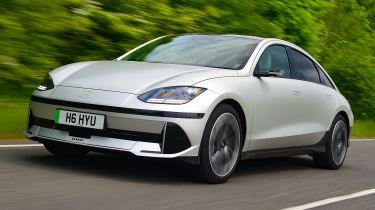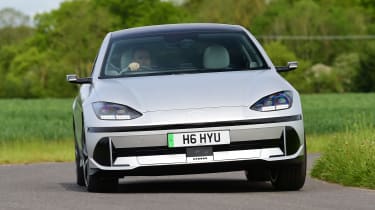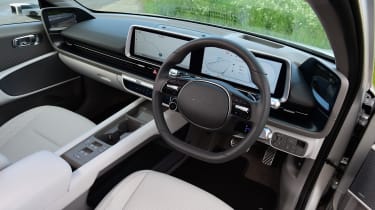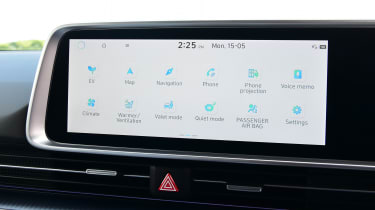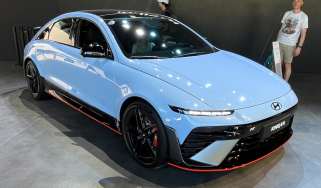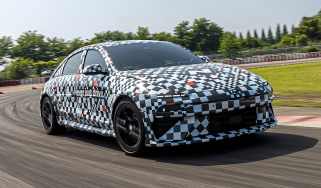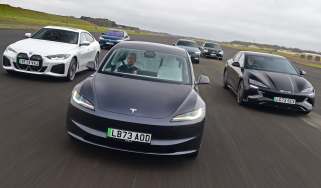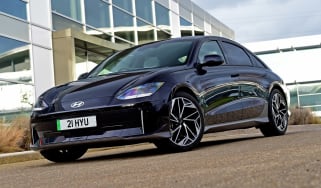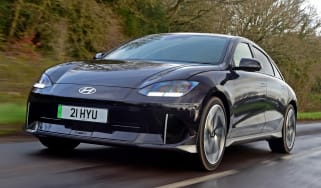Hyundai Ioniq 6 review: supercar looks with high-end EV technology
The Hyundai Ioniq 6 is a very impressive electric car with a unique look and excellent technology

Quick review
The Hyundai Ioniq 6 follows on pretty much directly from the Ioniq 5 – our 2021 Car of the Year. It uses the same tech underneath but with a sleeker, saloon shape and slightly sharper handling than its hatchback sibling. Its bold looks aren’t for everyone, but its charging speeds, comfortable interior and excellent in-car tech mean it’s up there with the best electric cars around.
It has a lot of the same strengths as the Ioniq 5, which is actually its biggest downfall. The Ioniq 6 is a bit less practical than its stablemate while also being a little more expensive to buy. But if you love how it looks, the Ioniq 6 is a fantastic car and well worth a look
About the Hyundai Ioniq 6
The original Hyundai Ioniq was a slightly oddball alternative to the Toyota Prius, but in 2020 the Ioniq name was used to create a sub-brand of EVs within the company’s regular line-up. The first model to arrive was the Ioniq 5 hatchback in 2021, followed by the Ioniq 6 saloon in 2022, and an Ioniq 7 flagship SUV is already in the works.
Dubbed the “electrified streamliner” by Hyundai, the Ioniq 6 draws heavily from the Hyundai Prophecy concept car we fell in love with in 2020. The saloon also takes some of the Ioniq 5’s design cues, such as the square pixel lights and chiselled body lines, and applies them to a much more dramatic silhouette. The result is an incredibly low drag coefficient of just 0.21Cd, and looks that will turn more heads than some supercars.
Used - available now

2025 Hyundai
Ioniq 6
7,990 milesAutomaticElectric
Cash £24,299
2023 Hyundai
Ioniq 6
28,400 milesAutomaticElectric
Cash £23,495
2025 Hyundai
Ioniq 6
10,504 milesAutomaticElectric
Cash £27,848
2025 Hyundai
Ioniq 6
9,978 milesAutomaticElectric
Cash £25,845The Ioniq 6 uses the same Electric Global Modular Platform (E-GMP) that underpins the Ioniq 5, along with other models such as the Kia EV6 and EV9, and the Genesis GV60. One benefit of the platform is an 800V charging system that allows the Ioniq 6 to charge at up to 220kW, meaning a 10 to 80 per cent top-up from a suitable rapid charger takes just 18 minutes.
Every Ioniq 6 is powered by a 77.4kWh battery (74kWh useable) that provides a range of up to 339 miles with rear-wheel drive (RWD) or 323 miles with all-wheel drive (AWD). The former uses a single 225bhp electric motor, while the latter has an additional motor at the front for a total of 321bhp on tap.
There are now just two trim levels for buyers to choose from: Premium and Ultimate. All models are very well equipped, with standard kit including 20-inch alloy wheels, two 12.3-inch displays, Apple CarPlay, Android Auto, LED headlights and tail-lights, heated front and rear seats, plus oodles of safety features. Higher-spec cars get extras like digital side mirrors, a Bose sound system and leather upholstery.
Electric motor, drive and performance
While the Hyundai Ioniq 6 has a sporty-looking silhouette, it doesn’t stand out in any particular area in terms of the driving experience.
On motorways and faster roads, it’s smooth and quiet, but the large 20-inch alloy wheels that are fitted as standard on all models mean that the Ioniq 6 isn’t quite able to keep lumps and bumps on B-roads in check. It feels unsettled and bouncy on rough sections, and the low-speed ride is no more than reasonable, feeling just as firm as the Polestar 2, and a little more crashy over potholes.
Surprisingly, the Ioniq 6 leans over more in corners than the BMW i4. The Ioniq 6 doesn’t feel unstable or unpleasant, but you won’t be as keen to push the car quite as hard as you might like in tight turns. The four-wheel drive model feels a little nose-heavy during quick changes of direction.
The steering is really light, meaning the car is easy enough to manoeuvre around town. There is a slight delay in response from the accelerator, which takes the edge off the otherwise strong performance of the more potent four-wheel drive version. For that reason, we’d lean more towards the rear-wheel drive version, which still has enough performance to impress just about anyone and nip into gaps in the traffic at roundabouts and junctions.
The brakes are amongst the best in the class, providing plenty of stopping power that’s easy to modulate from its well-weighted pedal. We also appreciate the paddles behind the steering column that allow you to adjust the strength of the energy recovery from the regenerative braking system, which ranges from full coasting to one-pedal driving. We wish every EV had a similar arrangement.
Inside, the Ioniq 6 is extremely quiet, making it a relaxing place to spend time if you maintain a calm driving style.
0-62mph acceleration and top speed
The Ioniq 6 is offered with a choice of rear-wheel drive (RWD) and all-wheel drive (AWD). The former uses a single motor producing 225bhp to drive the rear wheels, while the latter has another motor at the front for a combined power output of 321bhp.
Unsurprisingly, the AWD version is the faster of the two, with 0-62mph taking just 5.1 seconds. That’s less time than many sports cars and hot hatchbacks take, although the Tesla Model 3 Long Range (which also uses two electric motors for AWD) will do 0-62mph in an incredible 4.2 seconds. Regardless, the dual-motor Ioniq 6 feels very potent, plus there’s 605Nm of torque available as soon as you touch the accelerator.
The RWD model takes a little longer to get to 62mph – 7.4 seconds to be exact – but that’s still plenty quick enough for a family saloon car like this. Top speed for both versions stands at 115mph.
Range, charging and running costs
Every Hyundai Ioniq 6 is fitted with a sizeable 77.4kWh battery and boasts impressive rapid-charging capabilities. However the electric saloon’s maximum driving range varies depending on whether you go for rear- or all-wheel drive.
The RWD version has an official range of 339 miles, while Hyundai says the AWD version can cover up to 323 miles before the battery is out of juice. Those figures are a long way off the 391-mile range of the updated Tesla Model 3 Long Range, or the 406 miles you can cover in Long Range Single Motor Polestar 2.
During our electric company car group test with five of the main rivals to the Ioniq 6, the Hyundai posted the most disappointing efficiency figure. Its efficiency was only 3.1 miles per kWh, which was even lower than the 3.2 miles per kWh we got from an identical Ioniq 6 AWD when tested against a BMW i4 eDrive40. Based on a useable capacity of 74kWh, the Ioniq 6 AWD is likely only to have 230 miles of range, so we’d recommend sticking with the rear-wheel drive version to get better range and efficiency numbers.
It’s not the most efficient, but the Ioniq 6 makes up for that with its highly impressive 800V charging tech that allows it to accept a peak charging rate of up to 220kW. In other words, if you plug the Ioniq 6 into a 350kW ultra-rapid charger, a 10 to 80 per cent top-up can take as little as 18 minutes. That’s about 10 minutes quicker than it would take a BMW i4 to do the same job. Fully recharging the Ioniq 6’s 77.4kWh battery will take around 11 hours if you use a more typical 7kW home wallbox charger.
Tax
The Ioniq 6 is particularly appealing to company car drivers because it sits in the lowest possible bracket for Benefit-in-Kind (BiK) tax. This is the same for all electric cars currently, so while it’s great if you’re coming from a petrol or diesel car, it’s not a unique selling point for the Hyundai if you’re only considering electric models as a company car.
For now, zero-emission cars, regardless of list price, are in the UK's free road tax (VED) band. That will change from 2025 onwards, when electric car will have to start paying road tax and the London Congestion Charge.
Insurance
Insurance premiums for electric cars are generally higher than for the equivalent petrol or diesel-powered model, partly because of their rapid acceleration and the high price of repairs. Battery packs, in particular, are costly to replace.
It’s the same story with the Ioniq 6. The cheapest model to insure will be the entry-level RWD model, which sits in group 36 (out of 50), while the AWD versions, which are quite a bit faster, sit in group 41.
The BMW i4 attracts similar insurance ratings (groups 35-43), while the recently updated Polestar 2 will cost a little more to insure, given that it lands in groups 40-44. However the Tesla Model 3 is worse still, in groups 48-50.
Check if your car needs an MoT and view its complete history with our MoT History Checker...
Depreciation
According to our latest data, the Ioniq 6 will hold onto between 48 and 53 per cent of its original list price after three years and 36,000 miles of ownership. In case you’re wondering, the Ultimate trim models with four-wheel drive are projected to retain the least value, while the entry-level Premium-spec cars lead the pack.
In comparison, the BMW i4 and Polestar 2 are expected to retain 50-55 and 41-49 per cent of their value, respectively.
To get an accurate valuation on a specific model check out our free car valuation tool...
Interior, design and technology
The interior of the Hyundai Ioniq 6 isn’t quite as futuristic as the bold exterior of the “electrified streamliner”, but it does feature Hyundai’s excellent infotainment system and plenty of neat design touches, while the overall build quality is excellent.
Some of the Ioniq 5’s switchgear, including the rotary drive selector on the steering column and the unbranded two-spoke steering wheel, have been carried over into this saloon, though that’s hardly a bad thing. One obvious difference is the high centre console that separates the driver and front passenger in the Ioniq 6. It gives this model a more traditional sporty saloon-like feel in the cabin, although the driving position is still quite high up.
There are some more black plastic surfaces in the Ioniq 6 compared to the 5, which some will like, and others may think it adds a slightly less premium feel.
The Ioniq 6 is available in two trim levels: Premium and Ultimate. The entry-level model is our pick, because the higher trim level doesn't add a whole lot of extra kit and costs quite a bit more to buy.
All models come with 20-inch alloy wheels, LED lights all round, heated front and rear seats, two-zone climate control, auto lights and wipers, a heat pump, heated steering wheel, adaptive cruise control, a powered tailgate, two 12.3-inch displays and smartphone connectivity. Even metallic paint comes as standard.
Upgrading to Ultimate trim adds ventilated front seats, leather upholstery, a sunroof, a 360-degree parking camera and a Bose sound system. Ultimate-spec cars also get digital side mirrors, which replace the regular door mirrors with cameras, the feed from which is displayed on two screens either side of the dash. We’d avoid this trim because of these mirrors, because the narrow field of view they provide makes low-speed manoeuvres tricky.
Sat-nav, stereo and infotainment
Hyundai’s latest infotainment system is one of the most user-friendly set-ups around at the moment, and is packed with the latest features. Every Ioniq 6 comes with a 12.3-inch central touchscreen and a 12.3-inch digital driver’s display, which you can configure to show as much or as little information as you need.
All the menu layouts are logical, with large touchscreen buttons or a voice control system. The graphics aren’t quite as sharp as those in the BMW i4, but the screens respond just as quickly, and it’s simple enough to enter routes using the on-screen keyboard.
All models include Android Auto, Apple CarPlay, a wireless phone charging, and over-the-air updates. The built-in sat-nav system is also good and can direct you to nearby charging stations.
Practicality, comfort and boot space
The Hyundai Ioniq 6 has a very roomy interior, although it doesn’t feel as spacious and airy up front as the Ioniq 5. That’s partly because the Ioniq 6 features a large centre console, rather than the flat, open floor in its hatchback sibling.
At least you get plenty of storage space underneath the centre console, along with two cupholders and another cubby underneath the armrest. The centre console houses the controls for the windows, which is unusual. There’s a wireless phone charging pad on the console, although we found that devices can fall off quite easily.
Instead of a conventional glovebox, the Ioniq 6 features a very clever slide-out drawer that’s deeper than the glovebox in the BMW i4. Meanwhile, passengers in the rear have cupholders in the armrest, a pair of air vents, plus USB ports to keep their devices topped up.
Dimensions and size
The Ioniq 6 is 4,855mm long, 1,880mm wide (excluding side mirrors) and 1,495mm tall. That means it’s longer than the Ioniq 5 and significantly lower, too. That’s obvious from the car’s shape, though: the roofline is sleeker, and the overhang behind the rear wheels is where that extra length comes from. It’s also longer, taller and wider than a BMW i4, although not by a huge amount.
Leg room, head room & passenger space
Unfortunately that rakish roofline does mean that there’s not as much room in the back seats for adults as you get in the Ioniq 5 hatchback. The roof slopes down over the seats and taller people will find their head brushing against it, which can get annoying on longer trips.
There’s plenty of legroom, though, and kids will be very comfortable in the back, especially as every model comes with heated rear seats. The tallest adults may also find that the low roofline affects them up front as well. The Ioniq 6 comes with ISOFIX child seat mounting points on the outer positions on the rear bench.
Boot space
The boot in the Ioniq 6 is wide and long but quite shallow, and the opening itself isn’t the most practical shape – especially when compared to the hatchback tailgates on the BMW i4, Polestar 2, and Volkswagen ID.7. The Ioniq 6’s 401-litre boot is on par with that in both the Polestar and Tesla Model 3, though. Plus, there’s a further 45 litres of storage in the ‘frunk’ under the bonnet, which is useful for charging cables, but in the AWD model, this shrinks to a close-to-useless 14.5 litres.
You can fold down the 60:40-split back seats in the Ioniq 6, but they can only be operated by levers in the boot, not from the cabin. And with them down, you’re left with a narrow opening here, too.
Towing
The Ioniq 6 can tow up to 1,500kg, whether you opt for a RWD or AWD model. This is okay and better than many electric cars that aren’t rated for towing at all, but it’s still not ideal, and a combustion, hybrid or plug-in hybrid car is probably still a better bet for those who tow regularly.
Reliability and safety
The Hyundai Ioniq 6 didn’t make our most recent list of the best cars to own, but that’s not surprising considering how new it is. However, based on the results of the 2023 Driver Power customer satisfaction survey, the closely related Kia EV6 seems to have made a very positive impression on owners. In fact, it managed to rank among the top 10 best cars to own.
However, Hyundai finished a middling 17th in our ranking of the best car manufacturer rankings, which suggests owners aren’t quite as happy as they could be with the brand’s service.
Euro NCAP crash tested the Ioniq 6 in 2022 and awarded it the industry body’s maximum five-star safety rating. It scored a very impressive 97 per cent in the adult occupant protection section and 90 per cent for its safety tech.
Every Ioniq 6 comes with autonomous emergency braking (AEB), Highway Drive Assist (autonomous cruise control) and Intelligent Speed Limit Assist, plus Lane Keep Assist, Blind Spot Collision Avoidance Assist and Rear Cross Traffic Collision Avoidance. Many of these functions are available in other electric cars, but they are usually optional extras, so it’s good to see that Hyundai includes them all in every version here. A 360-degree parking camera is the only item of safety tech reserved for higher-spec Ultimate models.
Warranty
A five-year, unlimited-mileage warranty covers every Hyundai. It’s one of the best packages around, beaten only by Kia and MG’s seven-year factory warranty. Also included in Hyundai’s coverage are 12 months’ roadside assistance and free annual health checks (visual inspections) of your vehicle.
The Ioniq 6’s battery pack is covered by a separate eight-year, 125,000-mile warranty, which guarantees that it will retain over 70 per cent capacity over that time and mileage period, similar to most electric vehicles.
Servicing
Servicing for the Ioniq 6 is required every two years or 20,000 miles. That’s a similar period to most electric vehicles, but the mileage is somewhat short of the unlimited distance you can cover with the Volkswagen ID.7 between trips to the dealer.
Hyundai offers flexible servicing plans designed to meet your individual requirements. You can get a quote on the brand’s website, with the price based on the model you own, your expected mileage, and the period you’d like the plan to cover. You can spread the cost with interest-free monthly instalments or pay in one lump sum.
Hyundai Ioniq 6 Alternatives
Key rivals include the fellow electric saloons like the BMW i4, Polestar 2, BYD Seal, Tesla Model 3, and the Volkswagen ID.7. The closely related Kia EV6 is another alternative, but perhaps the biggest is Hyundai’s own Ioniq 5, which has most of the same appeal as the Ioniq 6 in a more practical package.
